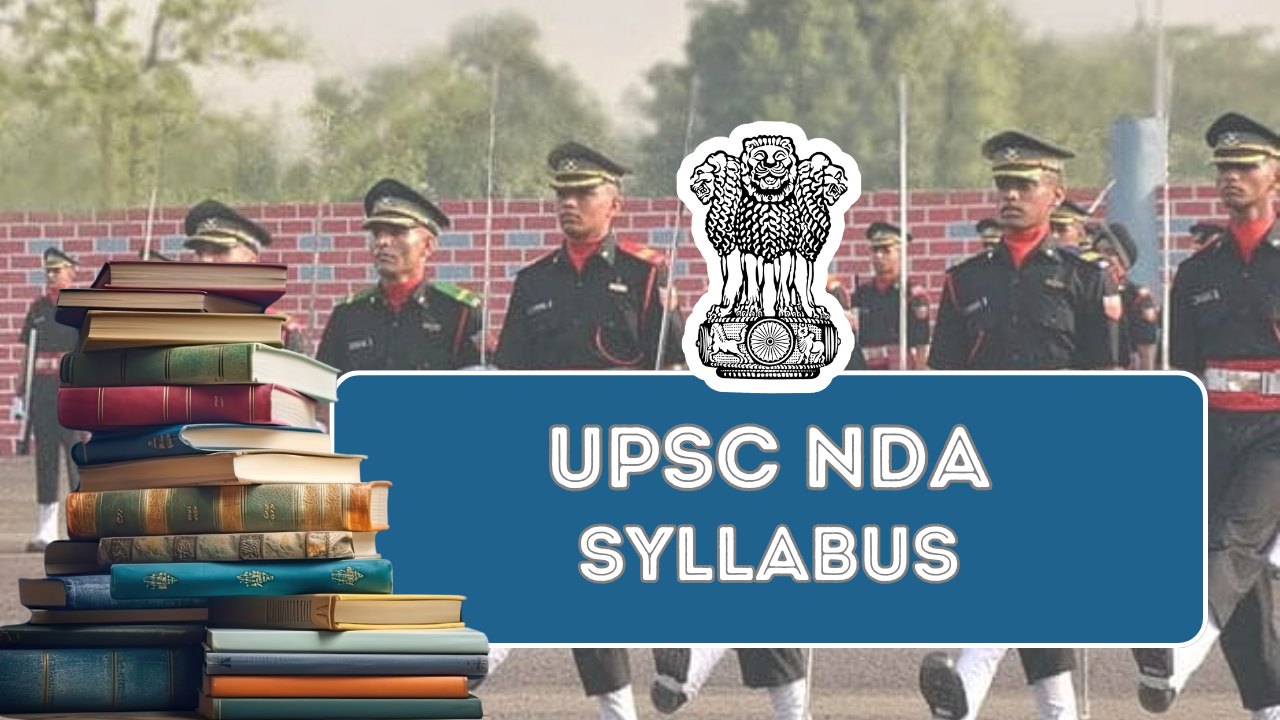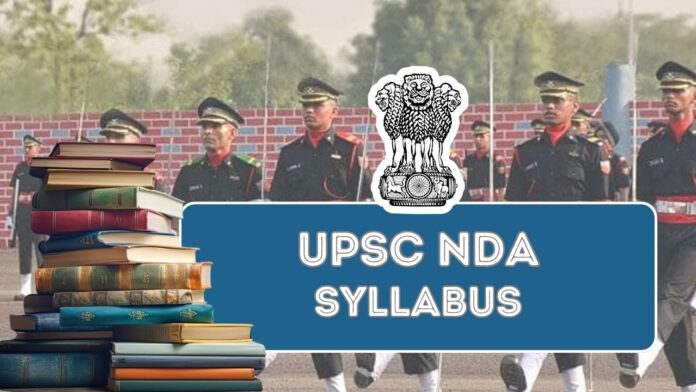The Union Public Service Commission (UPSC) conducts the National Defence Academy (NDA) and Naval Academy (NA) Examinations to select candidates for the Indian Armed Forces. The NDA exam is highly competitive, and understanding the syllabus and examination scheme is crucial for success.
The NDA exam is typically conducted twice a year, in April and September. The UPSC announces the exact dates on their official website accordingly. The exam consists of two papers on the same day, each lasting 2½ hours. This article provides a detailed overview of the UPSC NDA syllabus, examination scheme, paper pattern, and physical standards required for candidates.
UPSC NDA Syllabus 2024

| Exam Name | NDA 2024 |
| Exam Authority | Union Public Service Commission (UPSC) |
| Exam Name | National Defence Academy and Naval Academy |
| Article Category | Syllabus |
| Job Location | PAN India |
| Website | upsc.gov.in |
UPSC NDA Exam Overview
| Subject | Code | Duration | Maximum Marks |
|---|---|---|---|
| Mathematics | 01 | 2½ Hours | 300 |
| General Ability Test | 02 | 2½ Hours | 600 |
| Total (Written Exam) | 900 | ||
| SSB Test/Interview | 900 | ||
| Grand Total | 1800 |
UPSC NDA Selection Procedure
The selection process for the NDA exam involves two main stages: the written examination and the SSB Interview. Candidates who clear the written exam are called for the SSB Interview, which includes psychological tests, group tasks, and personal interviews. The final merit list is prepared based on the combined scores of the written exam and the SSB Interview.
UPSC NDA Exam Scheme & Paper Pattern
The NDA examination consists of two papers: Mathematics and General Ability Test. The detailed paper pattern is as follows:
Mathematics (Paper I)
- Duration: 2½ hours
- Maximum Marks: 300
- Type of Questions: Objective type
- Syllabus:
- Algebra
- Matrices and Determinants
- Trigonometry
- Analytical Geometry of Two and Three Dimensions
- Differential Calculus
- Integral Calculus and Differential Equations
- Vector Algebra
- Statistics and Probability
General Ability Test (Paper II)
- Duration: 2½ hours
- Maximum Marks: 600
- Type of Questions: Objective type
- Syllabus:
- Part A: English (200 Marks)
- Grammar and usage
- Vocabulary
- Comprehension
- Cohesion in extended text
- Part B: General Knowledge (400 Marks)
- Physics (Section A)
- Chemistry (Section B)
- General Science (Section C)
- History, Freedom Movement, etc. (Section D)
- Geography (Section E)
- Current Events (Section F)
- Part A: English (200 Marks)
Physical Standards for NDA
Candidates must meet specific physical standards to be eligible for the NDA. The standards include height, weight, vision requirements, and general physical fitness.
Height and Weight Standards
The minimum acceptable height for male candidates is 157 cm, with variations allowed for candidates from specific regions. Weight should be proportionate to height according to the standards provided.
| Height (cm) | Weight (Kg) |
|---|---|
| 152 | 42.5 – 47.5 |
| 155 | 43.5 – 48.5 |
| 157 | 45.0 – 50.0 |
| 160 | 46.0 – 52.0 |
| 162 | 47.0 – 53.0 |
| 165 | 48.0 – 54.0 |
| 167 | 49.0 – 55.0 |
| 170 | 50.0 – 57.0 |
| 173 | 51.0 – 59.0 |
| 175 | 52.0 – 61.0 |
| 178 | 54.0 – 62.0 |
| 180 | 55.0 – 64.0 |
| 183 | 57.0 – 66.0 |
UPSC NDA Written Test Syllabus
The National Defence Academy (NDA) exam conducted by the Union Public Service Commission (UPSC) is one of the most prestigious exams in India. Candidates need to understand the syllabus to excel in the exam thoroughly. The written test consists of two papers: Mathematics and the General Ability Test (GAT). Below is a detailed syllabus for both papers:
Paper I: Mathematics
The Mathematics paper tests a candidate’s understanding of mathematical concepts. It carries a total of 300 marks and has a duration of 2½ hours. The questions are objective type and cover a wide range of topics.
- Algebra:
- Concept of set, operations on sets, Venn diagrams
- De Morgan laws, Cartesian product, relation, equivalence relation
- Complex numbers – basic properties, modulus, argument, cube roots of unity
- Binary system of numbers, conversion of a number in decimal system to binary system and vice-versa
- Arithmetic, geometric and harmonic progressions
- Quadratic equations with real coefficients
- Permutation and combination, Binomial theorem and its applications
- Logarithms and their applications
- Matrices and Determinants:
- Types of matrices, operations on matrices
- Determinant of a matrix, basic properties of determinants
- Adjoint and inverse of a square matrix
- Applications – solution of a system of linear equations using Cramer’s rule and matrix method
- Trigonometry:
- Angles and their measures in degrees and in radians
- Trigonometrical ratios, trigonometric identities, sum and difference formulae
- Multiple and sub-multiple angles, inverse trigonometric functions
- Applications – height and distance, properties of triangles
- Analytical Geometry of Two and Three Dimensions:
- Rectangular Cartesian coordinate system, distance formula
- Equation of a line in various forms, the angle between two lines
- Distance of a point from a line, equation of a circle in standard and general form
- Standard forms of parabola, ellipse and hyperbola
- Eccentricity and axis of a conic
- Point in a three-dimensional space, the distance between two points
- Direction cosines and direction ratios
- Equation of a plane and a line in various forms, the angle between two lines and two planes
- Equation of a sphere
- Differential Calculus:
- Concept of a real-valued function – domain, range and graph of a function
- Composite functions, one-to-one, onto and inverse functions
- The notion of limit, standard limits, continuity of functions
- Derivative of a function, geometrical and physical interpretation of a derivative
- Derivatives of sum, product and quotient of functions
- Derivative of a function for another function
- Second-order derivatives, increasing and decreasing functions
- Application of derivatives in problems of maxima and minima
- Integral Calculus and Differential Equations:
- Integration as inverse of differentiation
- Standard integrals involving algebraic expressions, trigonometric, exponential and hyperbolic functions
- Evaluation of definite integrals, determination of areas of plane regions bounded by curves
- Formation of a differential equation, general and particular solution of a differential equation
- Solution of first-order and first-degree differential equations of various types
- Application in problems of growth and decay
- Vector Algebra:
- Vectors in two and three dimensions, magnitude and direction of a vector
- Unit and null vectors, addition of vectors, scalar multiplication
- Scalar and vector products of two vectors
- Applications – work done by a force and moment of a force
- Statistics and Probability:
- Classification of data, frequency distribution, cumulative frequency distribution
- Graphical representation – histogram, pie chart, frequency polygon
- Measures of central tendency – mean, median, mode
- Variance and standard deviation, correlation and regression
- Probability – random experiment, outcomes, sample space, events
- Mutually exclusive and exhaustive events, elementary theorems on probability
- Conditional probability, Bayes’ theorem, random variables, binomial distribution
Paper II: General Ability Test (GAT)
The General Ability Test paper is divided into Part A (English) and Part B (General Knowledge), and carries 600 marks. The duration of the paper is 2½ hours, and the questions are objective type.
- Part A: English (200 Marks):
- Grammar and usage
- Vocabulary
- Comprehension
- Cohesion in extended text
- Part B: General Knowledge (400 Marks):
- Section A: Physics:
- Physical properties and states of matter, mass, weight, volume, density, specific gravity
- Motion of objects, velocity and acceleration, Newton’s laws of motion, force and momentum
- Effects of heat, measurement of temperature and heat, change of state, latent heat
- Sound waves and their properties, simple musical instruments
- Rectilinear propagation of light, reflection and refraction, spherical mirrors and lenses, human eye
- Magnetism, static and current electricity, simple electrical circuits
- Section B: Chemistry:
- Physical and chemical changes, elements, mixtures, compounds
- Properties of air and water, preparation and properties of hydrogen, oxygen, nitrogen, carbon dioxide
- Acids, bases, salts, different forms of carbon, natural and artificial fertilizers
- Materials used in the preparation of substances like soap, glass, ink, paper, cement, paints, safety matches, gunpowder
- Section C: General Science:
- Difference between the living and non-living
- Basis of life – cells, protoplasms, tissues
- Growth and reproduction in plants and animals
- Elementary knowledge of the human body and its important organs
- Common epidemics, their causes and prevention
- Food – source of energy for man, constituents of food, balanced diet
- Solar system, meteors and comets, eclipses
- Achievements of eminent scientists
- Section D: History, Freedom Movement, etc.:
- A broad survey of Indian history with an emphasis on culture and civilization
- Freedom movement in India
- Elementary study of the Indian Constitution and Administration
- Panchayati Raj, cooperatives and community development
- Basic teachings of Mahatma Gandhi
- Forces shaping the modern world, renaissance, exploration and discovery, wars, revolutions
- Impact of science and technology on society, United Nations, democracy, socialism, communism
- Section E: Geography:
- Earth, its shape and size, latitudes and longitudes, concept of time, international date line
- Movements of earth and their effects, the origin of earth, rocks and their classification
- Weathering, earthquakes, volcanoes, ocean currents, tides
- The atmosphere and its composition, temperature, atmospheric pressure, winds, cyclones, anticyclones, humidity, condensation, precipitation
- Types of climate, major natural regions of the world, regional geography of India
- Location and distribution of agricultural and industrial activities
- Important sea ports and main sea, land, and air routes of India
- Main items of imports and exports of India
- Section F: Current Events:
- Knowledge of important events that have happened in India in recent years
- Current important world events
- Prominent personalities – both Indian and international, including those connected with cultural activities and sports
- Section A: Physics:

